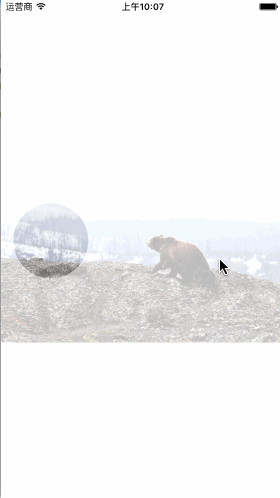mask Property An optional layer whose alpha channel is used to mask the layer’s content.
Discussion
Special Considerations
Availability
以上是Mask 在Apple的的官方文档中的描述,不难看出Mask在一般情况下是不存在,默认是nil.Mask 相当于一个遮盖,覆盖在视图Layer的上层,如果将视图Layer称之为ContentLayer,可以通过控制Mask 的opacity(=alpha),bounds和<path>路径来控制ContentLayer的显示范围和透明度
在Mask 范围之外的ContentLayer将不被显示(相当于没有绘制在屏幕上,可以看到ContentLayer背后的视图)
在Mask 范围之内的ContentLayer = ContentLayer的opacity * **Mask**的opacity,也就意味着Mask 的opacity为0或1时ContentLayer显示或不显示,当其为0.x时ContentLayer为半透明状态
特别需要注意的是,Mask 的背景色为clearColor也会被认为时opacity为0
官方文档中已经警告:当你给Mask赋值时需要注意Mask不能拥有superLayer,否者Mask将会失效产生意想不到的后果
机智的小伙伴们可以发现Mask并没有指定图层类型,在大纲中,我们已经知道了CALayer的类型有很多种,这样的话就可以利用一些特殊的图层实现一些新奇的动画效果:
1 2 3 4 5 6 7 8 9 10 11 12 13 14 15 16 17 18 19 20 21 22 23 24 25 26 27 28 29 30 31 32 33 34 35 36 37 38 39 40 41 42 43 44 45 46 47 48 49 50 51 52 53 54 55 56 57 58 59 60 61 62 import UIKitclass ViewController : UIViewController { var myImageView:UIImageView ! var maskLayer:CAShapeLayer ! override func viewDidLoad () { super .viewDidLoad() setupUI() } func setupUI () { let image = UIImage (named: "_snqARKTgoc" ) let inputImage = CIImage (CGImage: image! .CGImage !) let filter = CIFilter (name: "CIColorControls" ) filter? .setValue(inputImage, forKey: "inputImage" ) filter? .setValue(0.5 , forKey: "inputBrightness" ) let outputImage = UIImage (CIImage: filter! .outputImage! ) let bgImageView = UIImageView () bgImageView.image = outputImage bgImageView.frame = CGRectMake (0 , 0 , self .view.bounds.size.width, self .view.bounds.size.width * (image! .size.height/ image! .size.width)); bgImageView.center = CGPointMake (self .view.center.x, self .view.center.y - 1 ) self .view.addSubview(bgImageView) let imageView = UIImageView () imageView.image = image imageView.frame = CGRectMake (0 , 0 , self .view.bounds.size.width, self .view.bounds.size.width * (image! .size.height/ image! .size.width)); myImageView = imageView imageView.center = self .view.center self .view.addSubview(imageView) let shapLayer = CAShapeLayer () let path = CGPathCreateMutable () maskLayer = shapLayer shapLayer.bounds = CGRectMake (0 , 0 , 100 , 100 ) CGPathAddEllipseInRect (path, nil , CGRectMake (0 , 0 , 100 , 100 )) shapLayer.opacity = 0.5 shapLayer.position = CGPointMake (200 , 100 ) shapLayer.path = path shapLayer.fillColor = UIColor .blackColor().CGColor imageView.layer.mask = shapLayer } override func touchesBegan (touches : Set <UITouch >, withEvent event : UIEvent ?) { for touch in touches { let touchPoint = touch.locationInView(self .view) if self .myImageView.frame.contains(touchPoint) { let realPoint = touch.locationInView(self .myImageView) maskLayer.position = realPoint } } } override func didReceiveMemoryWarning () { super .didReceiveMemoryWarning() } }
#####扩展:
使用其他的图层(CAGradientLayer)可以实现更多炫酷的效果,如iPhone的左滑解锁字体高亮,详细的实现方式会在后续的篇幅中结合CAGradientLayer一块总结

